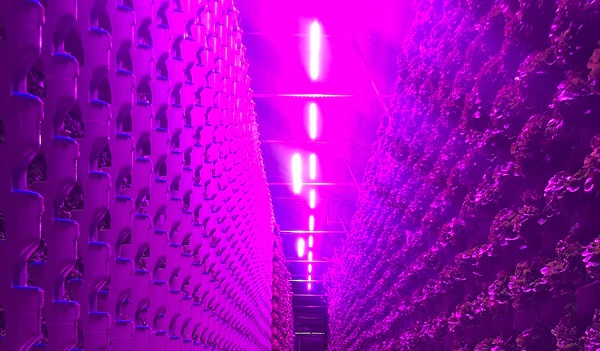
As LED lighting has become more common among farmers, this technology has been rapidly advancing to meet their needs. As a matter of fact, luminaries have become more efficient, flexible, and powerful.
Now LED lights are becoming even smarter. Studies have been done with color controllable LED lights in one research facility, proving they offer a whole new level of lighting versatility for indoor cultivation facilities.
This extensive research carried out with these dynamic light recipes aims to share the remarkable results we have witnessed. That said, let’s look at what vertical LED grow lights offer crops and farmers in general.
Transforming Unripe Crops to Ripe Before Harvest
The red color spectrum offered by LED grow lights in vertical farms is perhaps the best demonstration of how these lights can enhance a farmer’s business. Several pre-harvest treatments have been done on leafy greens by altering the light level days before harvest.
Green leaves are usually very efficient in photosynthesis, while red leaves, for instance, in lettuce, mizuna, opal basil, or red bok choy, are much less efficient. Outdoor conditions have no power over whether these crops develop green or red leaves.
However, when indoors, dynamic light recipes can be used to develop a robust shade of green and efficient leaves. In addition, the deployment of the red spectrum will trigger the growth of red pigments on the skins of crops prior to harvest. This helps farmers get more yields from their healthier and more brilliantly pigmented red crops.
Decreasing Nitrogen Levels in Leafy Greens
In lettuce and spinach, applying a specific light recipe just a couple of days prior to harvest can decrease the nitrogen levels. However, when planting in a greenhouse or outdoors, it won’t be easy to regulate the amount of nitrogen during specific year periods.
Utilizing a dynamic light recipe at the culmination of the growth phase enables farmers to decrease nitrogen concentration, thereby giving them control over these nitrogen levels.
This is especially useful for a couple of states where farmers are burdened with very strict nitrogen limits, which are difficult to meet during specific year periods. Therefore a suitable light recipe can be the difference between a discarded crop and a sellable one.
Enhancing Vitamin C Creation in Some Veggies
You can double the vitamin C content of some veggies such as arugula using specific light spectrums. The enhanced concentration levels will occur in the leaves.
The values obtained in this study are above those published by the USDA (united states department of agriculture) for arugula bringing the vitamin C levels of this leafy vegetable closer to what you see in vitamin-C concentrated crops such as kiwi fruit.
This proves that it’s viable to naturally boost the content of functional components in crops by growing them differently. In addition, this allows farmers to utilize vertical LED lights to meet the growing demand for functional crops from well-being-conscious clients.
Boosting the Shelf Life of Most Crops
Another thing you should know about LED grow lights is that they can extend the lifespan of crops. Depending on the crop, these lights can extend the lifespan by up to six days. This gives farmers a massive advantage because a lot of their produce doesn’t go to waste.
Other Benefits of Dynamic Vertical LED Grow Lights
The secret to incredible results in vertical farming lies with the flexibility that LED grow lights offer farmers. These lights can vary the color spectrum and light intensity to change certain crop features such as color, dietary content, taste, and textures without forcing the farmer to change the lighting installation in the indoor cultivation facility.
Color changeable lighting also offers precise business benefits. For instance, they can make a vertical farming facility more versatile such that various crops can be grown at different points in time compared to dedicated lighting fixtures with permanent lighting parameters.
What’s more, they reduce installation and logistics, thereby decreasing labor costs because a single color-changeable fixture can do the work of a couple of dedicated fixtures. As a result, farmers can save on power bills by changing the light level to each growth phase.
LED grow lights also give farmers an extra competitive edge by enabling them to fine-tune the development and morphology of a crop to improve quality and yield.
What Does The Future Hold For Vertical Farms?
Imagine walking into your neighborhood grocery shop to get freshly harvested basil, lettuce, strawberries, and tomatoes, all of which were obtained from a local farm only a couple of hours before you arrived at the shop.
You might be thinking of getting that fresh produce from vertical farms where farmers cultivate indoors year-round by regulating carbon dioxide, light, humidity, and temperature levels.
Overall fresh produce cultivated in indoor vertical farming facilities only travels a couple of kilometers to get to grocery ships compared to greenhouse or outdoor produce, which can travel hundreds of kilometers by plane or truck.
Beyond offering fresh local produce, vertical indoor farming can help boost food production and increase farming operations as the global population is expected to go beyond 9B by 2050. In the same year, two out of three people are projected to reside in urban settlements.
Producing fresh fruits and veggies in an environmentally dependable and sustainable manner by decreasing distribution links to offer lower emissions, providing higher-nutrient fruits and veggies, and massively decreasing water usage and wastage.
It’s exciting to learn about the potential prospects that vertical farming offers to address food insecurity. This is why the USDA (united states department of agriculture) already has set up some funding and research opportunities.
Likewise, NIFA ( National institute for food and agriculture) is offering funding opportunities that could shape future agriculture discussion and research.
Final Thought
This is just the beginning, and we expect to see an explosion of fresh developments with regard to vertical farming LED lights. How can we use them to boost nutritional compounds in crops further? How can varying sunrise and sunset instances benefit crops? The number of options available in offering varying wavelengths throughout the day is practically endless.




